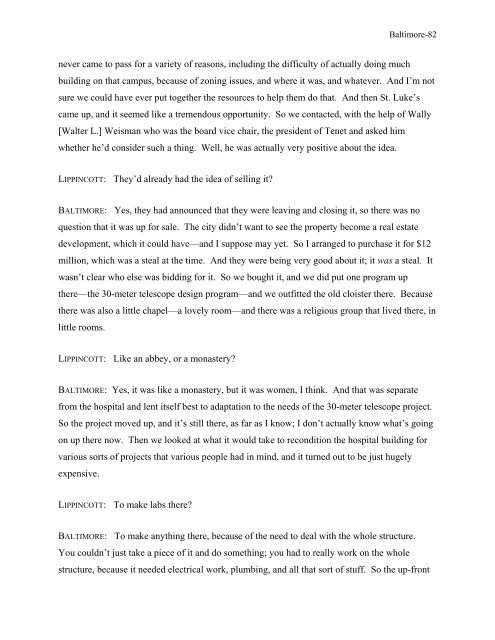Interview with David Baltimore - Caltech Oral Histories
Interview with David Baltimore - Caltech Oral Histories
Interview with David Baltimore - Caltech Oral Histories
Create successful ePaper yourself
Turn your PDF publications into a flip-book with our unique Google optimized e-Paper software.
<strong>Baltimore</strong>-82<br />
never came to pass for a variety of reasons, including the difficulty of actually doing much<br />
building on that campus, because of zoning issues, and where it was, and whatever. And I’m not<br />
sure we could have ever put together the resources to help them do that. And then St. Luke’s<br />
came up, and it seemed like a tremendous opportunity. So we contacted, <strong>with</strong> the help of Wally<br />
[Walter L.] Weisman who was the board vice chair, the president of Tenet and asked him<br />
whether he’d consider such a thing. Well, he was actually very positive about the idea.<br />
LIPPINCOTT: They’d already had the idea of selling it<br />
BALTIMORE: Yes, they had announced that they were leaving and closing it, so there was no<br />
question that it was up for sale. The city didn’t want to see the property become a real estate<br />
development, which it could have—and I suppose may yet. So I arranged to purchase it for $12<br />
million, which was a steal at the time. And they were being very good about it; it was a steal. It<br />
wasn’t clear who else was bidding for it. So we bought it, and we did put one program up<br />
there—the 30-meter telescope design program—and we outfitted the old cloister there. Because<br />
there was also a little chapel—a lovely room—and there was a religious group that lived there, in<br />
little rooms.<br />
LIPPINCOTT: Like an abbey, or a monastery<br />
BALTIMORE: Yes, it was like a monastery, but it was women, I think. And that was separate<br />
from the hospital and lent itself best to adaptation to the needs of the 30-meter telescope project.<br />
So the project moved up, and it’s still there, as far as I know; I don’t actually know what’s going<br />
on up there now. Then we looked at what it would take to recondition the hospital building for<br />
various sorts of projects that various people had in mind, and it turned out to be just hugely<br />
expensive.<br />
LIPPINCOTT: To make labs there<br />
BALTIMORE: To make anything there, because of the need to deal <strong>with</strong> the whole structure.<br />
You couldn’t just take a piece of it and do something; you had to really work on the whole<br />
structure, because it needed electrical work, plumbing, and all that sort of stuff. So the up-front

















